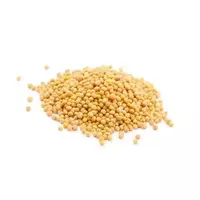Russian mustard (sarept)

The annual herbaceous plant of the Cabbage mustard family Sarepta or Brassica juncea has a number of other better known names. For example, in our latitudes, this type of mustard is usually called nothing more than Russian or sizaya. Mustard Russian (Sarept) got its distinctive name due to the distribution range of the plant. The fact is that in the wild, Russian mustard (Sarept mustard) is most often found in Siberia and other regions of the Russian Federation. Also, Sarept mustard is common in Central Asia, Mongolia and China.
In its appearance, Russian mustard (Sarept) resembles other varieties of the plant. The Russian mustard stem reaches a height of 150 cm. The leaves are curly petioles of a fairly large size. The plant blooms in small inflorescences that consist of golden flowers. Mustard fruits of Sarepta are cylindrical pods, inside which seeds of yellow or brown color are contained.
Currently, the plant is cultivated on an industrial scale in Europe, Africa, Asia. Russian mustard was brought to the territory of the Russian Federation from the territory of Asia. Initially, Sarept mustard was ranked among weed plants. However, over time, the beneficial and excellent taste properties of the seeds and oil of the plant were revealed. The name of the mustard Sarept came from the name of the Russian village of Sarepta, near which the first mustard fields began to be sown.
Until the beginning of the 20th century, Russian mustard (Sarept) was in demand abroad. Currently, Russian mustard is cultivated in the Rostov, Volgograd and Saratov regions of the Russian Federation, as well as in Siberia and the Stavropol Territory. The chemical composition of mustard sareptsky contains a large amount of essential oils. Mustard oil is enriched with natural amino acids that have a positive effect on the human body. The leaves of the plant contain iron, carotene, calcium and ascorbic acid. Mustard oil is extracted from the plant, which has become widely used in cooking.
Most often, Russian mustard oil (Sarept's) is used in baking bakery products and in confectionery production. In addition, elite varieties of canned fish products are prepared using mustard oil. In addition to mustard oil, plant seeds are used in cooking. Russian mustard seeds are considered the national seasoning in Asian countries. In our latitudes, the powder form of mustard-based seasoning is more common.
As a spice mustard Russian is perfectly combined with cold meat dishes. Whole mustard grains of Sareptsky are used in salting vegetables or in home canned fish. Often, fresh leaves of the plant are consumed, which are added to salads, as well as hot soups and meat dishes. From mustard powder, plants make the famous table mustard sauce, which fits perfectly with meat dishes. In China, Russian mustard plants consume salted or canned shoots for food.
Russian mustard (Sarept) 184.5 kCal
Energy value of Russian mustard (Sarept) (Ratio of proteins, fats, carbohydrates - ju):
Proteins: 8.7 g (~ 35 kCal)
Fats: 11 g (~ 99 kCal)
Carbohydrates: 11.6 g (~ 46 kCal)
Energy ratio (b | y): 19% | 54% | 25%
 Español
Español Français
Français Português
Português Русский
Русский 简体中文
简体中文 繁體中文
繁體中文 日本語
日本語 한국어
한국어 العربية
العربية Türkçe
Türkçe Қазақ
Қазақ Deutsch
Deutsch Italiano
Italiano Українська
Українська
